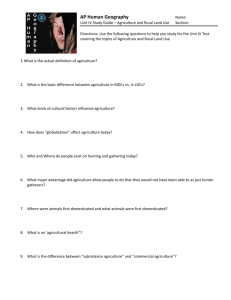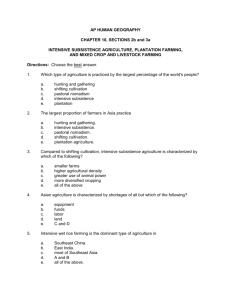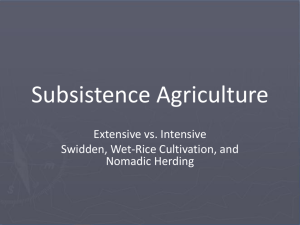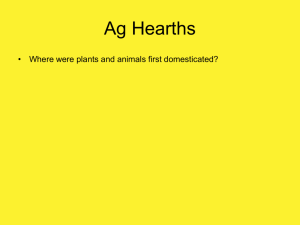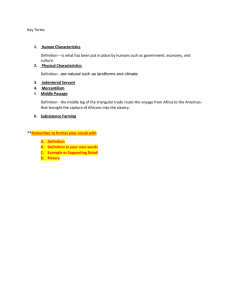Chapter 8 Livelihood and Economy
advertisement
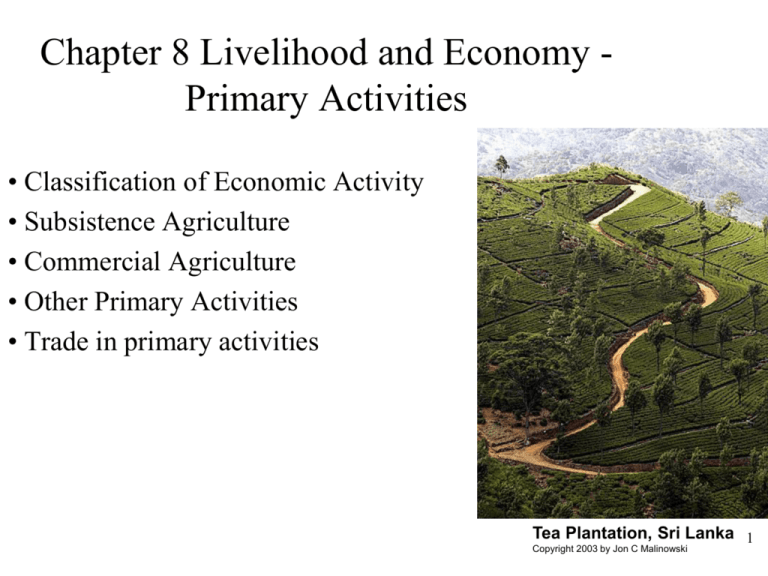
Chapter 8 Livelihood and Economy Primary Activities • Classification of Economic Activity • Subsistence Agriculture • Commercial Agriculture • Other Primary Activities • Trade in primary activities Tea Plantation, Sri Lanka 1 Copyright 2003 by Jon C Malinowski Classification of Economic Activities & Economics • Factors – – – – Physical environment and cultural considerations Exploitation of resources dependent upon technology Political decisions Quinary Activities Economic factors of demand Executive Decision Maker • Categories of Activity Quaternary Activities Info/Research/Management Tertiary Activities Retail & Wholesale/Personal & Prof. services Secondary Activities Manufacturing/Processing/Construction/Power Production Primary Activities Agriculture/Gathering/Extractive Industries 2 Types of Economic systems Subsistence Economy goods/services for the use of producers/family Commercial Economy producers market goods/services, supply-demand/competition Planned Economy government controlled/decided prices • Very few people are members of only one type of economic system • Systems subject to change - market/globalization • Transportation is a key variable • Isolation restricts the access to outside world (Fig 8.4-237) 3 Isolation restricts the access to outside world (Fig 8.4-237) • What are the challenges of isolation for a country like Congo?..For parts of China? 4 Primary Activities: Agriculture • Def. : growing crops and tending livestock, for sale or subsistence. (Fig 8.5 - growing season) • Referring back to figure 8.4 (isolation), can we identify a problem here…? 5 Primary Activities: Agriculture • 11% of the total earth land suitable for crop farming. • Declining trend in agriculture employment in developing countries (Fig 8.6 – Agricultural Employments) • What factors may explain this trend? Implications? 6 Primary Activities: Agriculture • Developed World Agric. Employment: <6% in most of W. Europe, < 3% in the US….Why? • Agriculture is still the major component of GDP in developing countries (Fig 8.7 – Agriculture and GDP,) -What are the Implications for development? 7 Agriculture Given the arable land and climate patterns of the earth, we should be able to feed approximately 12 Billion people. World agriculture produces 17 percent more calories per person today than it did 30 years ago, despite a 70 percent population increase. This is enough to provide everyone in the world with at least 2,720 kilocalories (kcal) per person per day • Paradox…Why do so many people go hungry? 8 Agriculture The Paradox: Identify reasons for hunger. Rice paddies in China http://www.confluence.org/cn/all/n26e115/pic2.jpg Food Security in a Hungry World Cali Drought Drought 2 Hunger Games: The price of feeding the world 9 Subsistence Agriculture • Involves nearly total self-sufficiency on the part of its members. No exchange (or minimal, if any). food for themselves only. • Two types – Extensive: • large areas of land and minimal labor input per unit area. Production and pop density is low. – Intensive: • cultivation of small landholdings through the expenditure of great amounts of labor per unit area. Production and pop density are both high. 10 Subsistence Agriculture (Figure 8.8 Subsistence Agriculture Areas) Note the paradox once again…Arable land, long growing season…subsistence activities. 11 Subsistence Agriculture Extensive or intensive? 12 Extensive Subsistence Agriculture • Nomadic herding (Figure 8.8 – Subsistence agriculture) - wandering and controlled movement of livestock dependent on natural forage - the most extensive type of land use system…Why? • Sheep, goat, and camels are most common (WHY) and others such as cattle, horses and yaks are important too. • Nothing is wasted - Animal provides milk, cheese, meat for food; hair, wool and skins for clothing; skin for shelter and excrement for fuel. • Nomadic herding is declining. Social/economic/culture changes are causing nomadic groups to alter their ways of life or disappear entirely. • Mongolia's Nomads 13 Extensive Subsistence Agriculture • Shifting cultivation - rotating fields once soils lose fertility. – Slash-and-Burn (or Shifting Cultivation) – No knowledge of soil chemistry, fertilizing, or irrigation, once the soil become infertile, they move to another parcel of land, clear the vegetation, turn the soil and try again. 150 to 200 million people in Africa, Middle America, tropical South America and parts of Southeast Asia. 14 Shifting cultivation/Slash-burn Extensive subsistence…Why? • Slash-and-burn : process of preparing low fertility soils for planting. Burning adds minerals to the soils, typically in low population areas • After burning, crops such as maize (corn) millet (cereal grain), rice, manioc, yam, and sugarcane are planted . • Slash and Burn Video Alternative Practices?? 15 Intertillage: practice of mixing different seeds and seedlings in the same swidden… Intensive or Extensive? • reduce the risk of disasters from crop failure • Increase the nutritional balance of the local diet. • Prevent loss of soil moisture. • Control of soil erosion R:Rice G:Groundnut M:Maize Y:Yam WY:White yam AP:Air potato V:Bamara groundnut Cu:Melon Pp:Pumpkin L:Gourds 16 Slash and Burn/Swidden Agriculture • Low pop. density much land is needed to support few people • Shifting Cultivation is founded on the islands of Kalimantan (Borneo), New Guinea, and Sumatra in Indonesia, and the uplands of SE Asia in Vietnam, Thailand, Myanmar and Philippines, Nearly the whole of Central and West Africa away from the coasts, Amazon basin, and large portions of Central America 17 Slash and Burn/Swidden Agriculture • Boserup thesis (p.241) Pop. increases necessitate increased inputs of labor and technology to compensate for reductions in the natural yields of swidden farming. The pop. increase forces an increased use of tech in farming, shifting societies from extensive to intensive subsistence agriculture. 18 Intensive Subsistence Systems • Half of the people of the world engaged in this activity • Exchange of farm commodities • Requires large inputs of labor, small plots and high reliance on fertilizers. • Plant grain, fruit, vegetables, and raise animals…Swine, ducks and chickens are main meat. Cattle used for labor and to produce fertilizers. • Mostly in densely populated, monsoon Asia. Warm and moist river valleys and deltas. 19 Intensive Subsistence Systems • Planting rice shoots by hand in standing fresh water is a tedious art Hand Planting Rice Rice provides 60% - 80% calories to over 2.8 billion pop. • Cooler/ drier Asia - wheat and millet is planted. 20 Intensive Subsistence Systems • Water management is crucial to the rice production – Rice Landscape - levees, reservoirs, canals, drainage channels, and terraces to extend level land to valley slopes 21 Urban Subsistence Farming • Provides 1/7 of the worlds food production - mostly in Asia, engaged in small garden plots, backyard livestock breeding and raising fish in ponds and streams. • In parts of the developing world, this has reduced the incidence of adult and child malnutrition in cities. Many rely on this as sole income. • Advantages- convert waste from problem to resource. Disadvantage - diseases, water pollution, etc. 22 A.E. Article Reviews Article 6 • 1 Risk Factors • 2. Mapping the Menace • 3. Climate Resilient Food • 4. Changing The System • 5. Markets and Models • 6. Let’s Be Civilized 23 Away from subsistence The Green Revolution The Power of Place: Small Farms, Big Cities 24 Origin of Green Revolution • Started in 1960s, Philippine researchers crossed a Chinese rice with Indonesian variety and produced IR8 rice with bigger head of grain and stronger stem. In 1982, they produced IR36, the most widely grown crop on Earth – IR36-mixed from 13 parents genetic resistance against 15 pests and growing cycle of 110 days which makes three crops per year possible. – Charting of genome is ongoing, it will eventually increase the production and develop the resistance to diseases and pests 25 Green Revolution • Green Revolution - trends in food production 1961-1999. Saving an estimated one billion people from starvation. Increased calories per person, pop with adequate food in developing countries jumped from 55% to 80%. • How do we explain Africa?.. 26 Green Revolution • Disadvantages?? – Water: irrigation destroyed large tracts of land, groundwater depletion, water wars, California Water War – For Further Investigation: Water Wars RT News/Water • Water Wars 27 Green Revolution • Disadvantages?? – loss of traditional/subsistence farming, food production aimed at export is more profitable, rural society destroyed, reduced variety of crops, rural pop moved to urban • Not all areas benefited from Green Revolution–reasons? (belated research effort, lack of investment (Africa) great range of growing conditions) 28 Green Revolution (Disadvantages) • “Genetic Erosion” – Loss of genetic diversity of crop varieties , fewer than 100 species provide most of the world’s food supply. • Is there a danger here? – Crop diversity and food security • Loss of domestic food availability: – Dependency on imported food… – vulnerable to currency exchange rates and inflation – Dependence on imported seed stock 29 Commercial Agriculture • Definition • 2 Facts (non-areal) • 2 Facts (areal) • 2 Advantages • 2 Disadvantages 30 Commercial Agriculture • The free market and Production Control – short supply should command an increased market price crop or livestock mix selected by commercial farmers reflects an assessment of market demands and prices…decisions guided by profit motive…not necessarily by what will feed the most people. Vertical Integration 31 Commercial Agriculture How do Governments distort Market Forces? – Inefficiencies of Govt. price controls –farm economy distorted while low food price is enforced – aimed at reducing imports and /or subsidizing nationals USDA subsidies in the United States totaled $277.3 billion from 1995-2011…. For Further Reading: Who gets the big U.S. farm subsidies…? Not farmers Roll back fat farm subsidies Subsidies Subsidies 2 EU Farmers 32 Why and Where: von Thunen’s model • intensity of land use, perishable goods are produced in land closer to the city. High shipping and high demand commodities found in inner rings. • “A portion of each crop is eaten by the wheels” - observed by von Thunen, distance between market and production site is the most important determination of the location • Transport gradients (8.15) - crops with highest transport cost and market values will be grown nearest to the market. •Transportation cost determines what and where we produce • Industrial and post-industrial economy, land use is less predictable…Why?..Rice in Japan??? 33 Warm – Up Von Thünen Model Central City Identify 1-6 and Respond to the Questions below 1. 2. 3. 3a. 3b. 4. 5. 6. * What does VonThunen’s model attempt to show? * Where (developed vs. developing world) is the model most applicable Today? Explain your assertions for both the developed and developing world. Von Thünen Model Application of Von Thünen Model • Geographer Lee Liu studied the spatial pattern of agriculture production in China. Found: - farmers living in a village farm both lands close to the village and far away intensively but with different methods…? - methods varied spatially – resulting in: * land improvement (by adding organic material) close to WHY? village and… * land degradation (lots of pesticides and fewer conservation tactics) farther from village…Why less care for the land further from the core. Intensive Commercial Agriculture • Characterized by high yields per unit of cultivated land • Large amount of inputs - justified by prices of fruits, vegetable and dairy products. – The goal is to decrease Per unit cost of production to increase profit – For instance - Truck Farms produce wide range of vegetable and fruits with refrigerated trucks and custom packaging close to urban areas. (distribution of truck farm 8.17) 37 Intensive Commercial Agriculture • Factory Farms Livestock-grain farming – growing grain for livestock feed. – reducing transportation cost. – Livestock price higher than feed, farmer convert their corn into meat on the farm by feeding it to the livestock. – In W. Europe, ¾ cropland is for livestock grain farm. However, the value of its products per unit is less than that of the truck farm. They are farther from the main markets than are horticultural and dairy farms. 38 Extensive Commercial Agriculture • Farmland values decline westward with increasing distance from the northeastern market of the US, but not increasing while near west coast. Climate and environmental considerations (increasing aridity and mountain ranges..) • Large-scale wheat farming - requires large amount capital input. Spring wheat (Dakotas, e Montana, S Canada) winter wheat (Kansas..) Argentina in S hemisphere. Wheat is the grain crop in the world…effect on grain price and small producers 39 Extensive Commercial Agriculture • Livestock ranching - oriented to the urban markets of industrialized countries. In developing countries - Typically Confined to areas of European settlement…WHY? – Caused destruction of tropical rain forests in Central America and the Amazon basin due to expanded cattle ranching. (in land with low quality soils, low pop density…requires fewer labor inputs) 40 Special Crops - mostly due to climate factors • Mediterranean agriculture - grapes, olives, oranges, figs, vegetables and similar commodities - needs warm temp. all year round plus summer sunshine. Summer drought and winter rain, irrigation system is needed. (8.21) • Plantation Crops - foreign to the areas (8.22) – tea in India and Sri Lanka, jute in India and Bangladesh, rubber in Malaysia and Indonesia, cacao in Ghana and Nigeria, can sugar in Cuba...., coffee in Brazil and Colombia, banana in central America. – Most plantations in coastal areas, easy for export. • Again, focusing on reduction of per unit cost. 41 Kuby Chapter 8 Activities 1&3 42 Activity 3: Remote Sensing & Agricultural Land Use Change Figure 8.11 (p. 245) Warm –Up Kuby Chapter 8 Review 1. What trends did you see in act. 8.3? 2. Identify possible externalities associated with those trends. New trends in American Agriculture? Will Allen Urban Agriculture 44 Primary Activities: Resource Exploitation • Gathering industries – – fishing and forestry • Extractive industries – – mining and quarrying • Renewable resources – – materials can be consumed and then replenished quickly by natural or by human-assisted processes. such as forest, fish, grasslands, and animals. – Maximum sustainable yield – -max. rate of use that will not impair its ability to be renewed or to maintain the same future productivity. If exceeded, renewable will become nonrenewable. -Nonrenewable resources – – exist in finite amount and are not replaced by natural processes. 45 Fishing - provide 19% of all animal protein in the human diet • steady fish harvest increase except in 1998 (El Nino) • 99% fish are from coastal wetlands, estuaries,and continental shelf. 1% from open sea. Commercial capture fishing for market only in northern hemisphere, tropical fish do not school and contain higher oil content, only for local use • Overfishing - due to the accepted view of “open seas/the commons” "75% of the major marine fish stocks are either depleted, overexploited or being fished at their biological limit.“ Collapse of the Cod Fishery Video 46 Fishing • Tragedy of the Commons - a open resource without collective controls exploited to the maximum extent The King of Sushi • Cod 99% of the worldwide annual commercial ocean catch comes from coastal waters, within 200 nautical miles of the coastline. these narrow coastal fringes are both the most productive and the most vulnerable." "Roughly one-third of the world's coral reef systems have been destroyed or highly degraded." 47 Exclusive Economic Zones Each coastal country has an EEZ extending 200 miles offshore. Legal mechanisms and investment incentives are being implemented to privatize and develop these marine areas for open ocean aquaculture and other industrial uses. This commercial exploitation will be beyond sub-national (state or provincial) regulation. Used offshore oil platforms are likely to be recycled as anchor points for large scale open net aquaculture. 48 Fishing • Tragedy of the Commons - an open resource without collective controls International Whaling Agreement • Aquaculture - farm ponds, catfish and crayfish ponds in SE US Aquaculture Urban Aquaculture Open Ocean Fish Farm • Mariculture - coastal lagoons, shallow water fish/shellfish 30% of worlds’ fish harvest from aquaculture and mariculture 49 The King of Sushi 50 Amazon Clear-cut Headlines…. Amazon deforestation jumps 69% in 2012 August 31, 2012 • “Deforestation in the Brazilian Amazon increased 69 percent in the past 12 months as high commodity prices have driven forest conversion for ranches and cropland, according to preliminary figures released by Brazil's National Institute for Space Research (INPE). The increase comes after three consecutive years of declining deforestation in Brazil.” 51 Forestry • Roundwood production – 45% for industrial consumption and 55% for fuelwood and charcoal. Developing countries rely on fuelwood and charcoal resulting in the serious depletion of tropical forest stands. In tropical areas, deforestation rates exceeds reforestation by 10 to 15 times. – since 1970s, 25 to 30 million acres of tropical forestland have been converted to agricultural land and in S and Central America additional millions of acres been cleared for beef cattle for the N American market – Half of roundwood production (for industrial markets) are from US,Canada and Russia and less than 20% from developing countries due to the transportation cost, explained by von Thunen’s model. 52 Mining • Involves the exploitation of minerals unevenly distributed in amounts and concentrations determined by past geologic events, not by contemporary market demand • Transportation costs play a major role in determining where lowvalue minerals will be mined • Depends on: - The occurrence of the perceived resources - The technology to exploit them 54 The End of Cheap Oil?? • Oil reserve - 1020 gbo (gigga-barrels of oil-gigga =a thousand million) 25 gbo/yr consumption, but with 2% increase of consumption, it won’t last 40 yrs. …..New discoveries - 7 gbo/yr 55 The End of Cheap Oil? • Americans consume 19 million barrels/year = about 1000 gallons/person/yr, – production=2.6 bbls in 2010. Proven reserves can only last 5 years without import. • Gulf of Mexico holds 15 bb of oil, high cost (Econ. And Environmental) required to exploit. • Oil Shale Fracking to the Rescue??? Four Level Analysis For Thursday Predict the Impact (Four-Level Analysis) An American Oil Find That Holds More Than All of OPEC By ALAN FARNHAM Nov. 13, 2012 CBS News 56 The New Oil Landscape Four-Level Analysis Costs and benefits/Short term and long term • Local State • National Global 57 An American Oil Find That Holds More Than All of OPEC Four-Level Analysis Costs and benefits/Short term and long term • Local State • National Global 58 Discussion Questions 1. What are the distinguishing characteristics of the economic systems labeled subsistence, commercial and planned? Are they mutually exclusive, or can they coexist within a single political unit? Give areal examples. 2. What are some of the ecological consequences of the different forms of extensive subsistence land use? In what world regions are such systems found? What, in your opinion, are the prospects for these land uses and for the way of life they embody 59 Key Terms w/areal specificity Economic geography Definition Explain with examples Primary activity Definition Explain with examples Secondary activity Definition Explain with examples Tertiary activity Definition Explain with examples technology Planned economy Definition Definition Explain with examples Explain with examples Commercial economy Definition Explain with examples Market economy Definition Explain with examples 60 Discussion Questions 3. How is intensive subsistence agriculture distinguished from extensive subsistence cropping? Why, in your opinion, have such different land-use forms developed in different areas of the warm, moist tropics? 4. Describe the Boserup thesis. a. Do you think it is a valid model for predicting the shift you described in “a” above? b. What other factors might bring about such a shift? 61 Key Terms w/areal specificity Quarternary activity Definition Explain with examples Quinary activity Definition Explain with examples Subsistence economy Definition Explain with examples agriculture Definition Explain with examples Intensive Agriculture Definition Explain with examples Nomadic herding Definition Explain with examples Shifting cultivation Definition Explain with examples Extensive agriculture 62 Discussion Questions 5. Briefly summarize the assumptions and dictates of von Thunen’s agricultural model. How might the land use patterns predicted by the model be altered by: a) an increase in the market price of a single crop? b) A decrease in the transportation costs of one crop but not of all crops? 6. What is the basic distinction between a renewable and non-renewable resource? Under what circumstances might the distinction between the two be blurred, or obliterated? Can you provide an example of such a situation today in the U.S? 63 Key Terms w/areal specificity Boserup Thesis Definition Explain with examples Green Revolution Definition Explain with examples Von Thunen Model Definition Explain with examples Truck farm Definition Explain with examples Plantation Definition Explain with examples resource Definition Explain with examples Natural resource Definition Explain with examples Renewable resource Definition Explain with examples 64 Discussion Questions 7. a) What economic and ecological problems can you cite that do or might affect the viability and productivity of the gathering industries of forestry and fishing? b) What is meant by the tragedy of the commons? How is that concept related to the problems you discerned in “a” above? 8. Mineral fuels What are the mineral fuels? Why have the mineral fuels been so important in economic development? What are the prospects for their continued availability What economic, environmental and social consequences might you anticipate if the price of mineral fuels should i) double? ii) be cut in half? 65 Key Terms w/areal specificity Non-renewable Resource Definition Explain with examples Extractive Industry Definition Explain with examples Gathering Industry Definition Explain with examples Maximum sustainable Yield Definition Explain with examples Tragedy of the Commons Definition Explain with examples Aqua-culture Defi nition Explain with examples Definition Explain with examples Useable reserves 66
